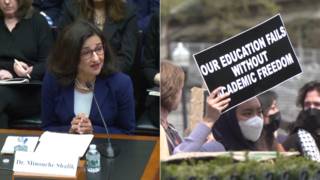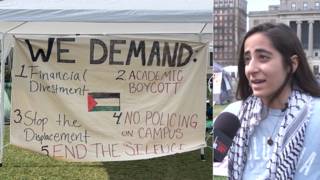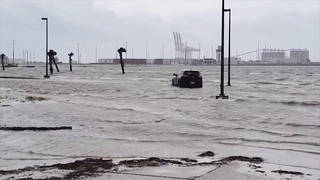
Related
Topics
Guests
- Harry Sheareractor, writer, director, satirist, musician and radio host. He is the voice of dozens of characters on The Simpsons, and his latest project is a feature-length documentary about the causes of the flooding of New Orleans called The Big Uneasy
On the fifth anniversary of Hurricane Katrina, a new documentary, The Big Uneasy, argues that the destruction of New Orleans was an unnatural disaster and how it could have been prevented. We speak with the filmmaker: actor and satirist Harry Shearer. [includes rush transcript]
Transcript
ANJALI KAMAT: This Sunday marked the fifth anniversary of Hurricane Katrina. Early on the morning of August 29th, 2005, the storm slammed into the Gulf Coast just south of New Orleans. It ravaged the coasts of Louisiana, Mississippi and Alabama and left over 1,800 people dead. Eighty percent of the city of New Orleans was under water after the levees failed.
President Obama visited New Orleans on Sunday and said that the construction of a fortified levee system to protect the city is underway. He called it a, quote, “a natural disaster but also a man-made catastrophe — a shameful breakdown in government that left countless men, and women, and children abandoned and alone.”
Well, we begin today’s show with a new documentary that gets the inside story of why the destruction of New Orleans was an unnatural disaster and how it could have been prevented. The Big Uneasy is a feature-length film by actor and satirist Harry Shearer. Here are some excerpts.
HARRY SHEARER: We all know what happened to New Orleans on August 29th, 2005: Katrina.
FOX NEWS: The biggest natural disaster in America.
P.J. CROWLEY: Katrina was a natural disaster.
SEN. CHRIS DODD: A major American city went through a natural disaster.
REV. AL SHARPTON: Unlike Katrina, where you had a natural disaster.
NEWT GINGRICH: When Katrina, the hurricane, did so much damage in New Orleans.
GERALDO RIVERA: This natural disaster befell New Orleans.
HARRY SHEARER: And yes, it’s true, the Mississippi Gulf Coast did suffer devastating damage from a hurricane that day, but as a part-time resident of New Orleans, I became aware over the weeks and months that followed the flood, as did everybody else here, that there was a very different side to that story.
IVOR VAN HEERDEN: We know that Katrina was about a one-in-thiry- to one-in-forty-year storm.
MAX MAYFIELD, Fmr. Director, National Hurricane Center: In fact, New Orleans proper likely experienced only Category 1 or Category 2 conditions.
IVOR VAN HEERDEN: This is contrary to the US Army Corps of Engineers, who are trying to claim that Katrina was a —-
COL. JEFFREY BEDEY, Fmr. Cmdr., Hurricane Protection Office, Army Corps of Engineers: One-in-496 probability of occurrence.
MICHAEL GRUNWALD: The Army Corps generals came out in their green suits and immediately said that -—
COL. JEFFREY BEDEY: That was a big storm.
IVOR VAN HEERDEN: The reason they’re doing that is to cover their behinds.
COL. JEFFREY BEDEY: And you can’t out-engineer Mother Nature.
IVOR VAN HEERDEN: Part of their defense was, this was a humongous storm.
KAREN DURHAM-AGUILERA, Army Corps of Engineers: Katrina was a storm that was, until then, unimaginable.
IVOR VAN HEERDEN: There would obviously be no oversight of the Corps of Engineers and their operations. And as we dug deeper, we found clerical errors, we found misinterpretation of data, misscribing data, as we looked from breach to breach. The kind of mistake at the London Avenue breach is what you learn about in second-year engineering.
JOHN BARRY, Member, Louisiana Coastal Protection & Restoration Authority: There was one contractor who in fact went to court, because he did not believe the flood wall he was building could hold in front of a storm, and he wanted the Corps to do it right.
LISA MYERS, NBC News: The contractor, Pittman Construction, told the Corps of Engineers that the soil and the foundation for the walls were “not of sufficient strength, rigidity, and stability.”
JOHN BARRY: He went to court. The Corps fought him and won. And he was compelled to build as designed, which he did. And it failed.
BRIG. GEN. MICHAEL WALSH: The design of those walls were based upon a standard Hurricane coming through. The Hurricane Katrina was much larger than what the walls were designed for.
IVOR VAN HEERDEN: In many locations, levees were built at ten feet when they should have been at fourteen feet. They had new model data available to them from 1979 onwards that they ignored.
MAJ. GEN. CARL STROCK, Fmr. Cmdr., US Army Corps of Engineers: The intensity of this storm simply exceeded the design capacity of this levee.
BOB BEA: This was not a natural disaster. In fact, this was a very unnatural disaster. This was a disaster caused by people. Following the release of a report, we’ve had three things coming back: “Atta boy! Go for it! Keep it up!”; the other one, deadly silence; and a third one, “Please shut up.”
ANJALI KAMAT: Excerpts from The Big Uneasy, a documentary by Harry Shearer that is playing tonight in theaters across the country.
Actor, writer, satirist, musician, director and part-time New Orleans resident, Harry Shearer, the voice of many characters on The Simpsons, joins me now from New Orleans.
Welcome to Democracy Now! Explain why you decided to make this film.
HARRY SHEARER: Really, very simple proximate cause. I was watching President Obama’s town hall meeting here last October, and when he referred to the flooding of New Orleans as a natural disaster, some three years after these two independent investigative forensic engineering reports had been issued, which agreed that this was a man-made disaster — in one case, the quote from the UC Berkeley people is the largest — “greatest man-made engineering catastrophe since Chernobyl” — when the President called it a natural disaster, I realized that what New Orleans knew, the rest of the country didn’t, that New Orleans had basically lost control of the narrative of its own near destruction. And I thought one way to try to get it back was to do a factual feature-length documentary.
ANJALI KAMAT: And what did you think of President Obama’s comments yesterday? He called it a natural disaster again, but he also said it’s a man-made catastrophe.
HARRY SHEARER: A man-made catastrophe related to the leaving people abandoned, referring to the government failure in the response. That’s exactly the same language he used last October. He refuses to acknowledge that an agency of the federal government, the US Army Corps of Engineers, under administrations of both parties over four-and-a-half decades, is — as the Corps has itself admitted — of course, the head of the Corps who admitted that was no longer the head of the Corps within a few months, but that the Corps was culpable for this disaster. Ray Seed of the University of California, Berkeley, team says clearly — it’s the first scene in my film — that had the right kind of hurricane protection been offered to New Orleans, the worst Hurricane Katrina would have done to New Orleans is, quote, “wet ankles.” If the President doesn’t acknowledge that, then we have no hope of getting this thing done right this time.
ANJALI KAMAT: Well, I want to go to a clip. President Obama and the Army Corps of Engineer’s promise that a new flood prevention system that will protect against the worst storm in the next hundred years will be ready by next June. This is Colonel Robert Sinkler, the Hurricane Protection Commander for the US Army Corps of Engineers.
COL. ROBERT SINKLER: The Corps of Engineers did take — accept responsibility primarily for the four failures that occurred on the outfall canals and in the Inner Harbor Navigation Canal, primarily due to design issues. But since then, we’ve actually taken those areas out of the system, and what we want to do is really fight the storm surge at the perimeter of the city, rather than allowing the storm surge to penetrate into the middle of downtown New Orleans.
ANJALI KAMAT: Harry Shearer, your response?
HARRY SHEARER: You have Colonel Sinkler admitting responsibility, which is one step beyond what the President has done. The Corps has adopted a perimeter response. It’s a good idea, assuming that all elements of the perimeter system are up to snuff, because once water gets in, they have not fixed the defective flood walls that failed so catastrophically last time.
In my film is a whistleblower from the Army Corps of Engineers whose responsibility was to test and install the new pumps on those outfall canals, which are essential to keeping those canals at a safe water level defined by the Corps. She says unequivocally the pumps never passed their testing. They failed. They self-destructed. They were installed anyway. And they will not withstand a hurricane event.
ANJALI KAMAT: Harry Shearer, your film goes into the wetlands around New Orleans. Talk about the role of the Army Corps of Engineers around this.
HARRY SHEARER: Well, you know, now the wetlands is the slow-motion disaster that’s been going on for the last thirty or forty years. The Corps leveed the Mississippi River in response to the flood, the disastrous flood down here, and they have succeeded in making the river not a threat to New Orleans. But the river, by flooding, would replenish the wetlands with sediment every flood time. And now that sediment gets dumped into a hole at the bottom of the Gulf of Mexico. The Corps didn’t really anticipate that that would start starving the wetlands.
Then the second blow to the wetlands was when oil was discovered in the Gulf and oil companies started making thousands of miles of canals and pipelines to get their equipment out to the Gulf and to bring the oil back. This allowed saltwater to intrude into the marsh, killing the vegetation, which then left the soil unanchored. And we’ve been losing an acre of marsh every hour for the last decade or two.
Richard Campanella, a geographer at Tulane who’s in my film, says we have a window of about ten to twenty years to start reversing this before sea level rise makes it a futile attempt. That’s another thing I looked for in the President’s speech yesterday, in vain, a commitment for serious resources to deal with coastal restoration. In this year’s budget, the President has asked for the munificent sum of $33 million, one-tenth of the amount of money he’s asked for to clean up the water in the Great Lakes, not nearly enough.
ANJALI KAMAT: And how does the oil spill disaster that continues to unfold in the Gulf of Mexico impact the wetlands and coastal restoration near New Orleans?
HARRY SHEARER: Well, you know, we know that there are some serious issues with regard to the deepwater, the plume and the existence of dispersed oil. The teams that have been out actually scouting the marsh, their initial reports, although they are subject to more rigorous science, are that the wetlands, you know, have not been as seriously affected by the spill as it was first feared. I think the most important thing about the BP oil spill with regard to the wetlands is it may have put the subject of Louisiana’s wetlands on the national agenda for a change, that people are now aware of this fragile but very important resource. The wetlands serve a huge function of what Bob Verchick of Loyola calls natural infrastructure. I don’t know the exact ratio, but they serve to buffer and beat down the ferocity of incoming hurricanes, both wind and storm surge, so they are our natural protection system, and we’ve been losing that, as I say, in a slow-motion disaster over three decades.
ANJALI KAMAT: Harry Shearer, talk about the distribution of your film. And your recent post on Huffington Post talks about ”NPR — The Initials Stand for Nothing.” Explain what you mean.
HARRY SHEARER: Well, NPR announced recently that they’re no longer National Public Radio, that the initials stand for, NPR. After I found out that they were not going to do a story about this film on either All Things Considered or Morning Edition
, I decided to buy some time — you know, those enhanced underwriting announcements at the end of each half-hour. And NPR legal told me this language was unacceptable, quote, “documentary about why New Orleans flooded.” The only language that they found acceptable was “documentary about New Orleans and Hurricane Katrina.” And when I told them it’s not about a hurricane, that was the end of the conversation.
ANJALI KAMAT: And your film is showing across the country tonight?
HARRY SHEARER: Mm-hmm, yes. I thought — I knew you could see sort of coming that the mainstream media were going to do basically reruns of the coverage from five years ago. Here’s me in water, and here’s me with a person on a roof, and more footage of suffering people and some “where are they now?” You know, where’s Ray Nagin now? Where’s Mike Brown now? But we’re still not going to ask the question, “Why did it happen?” So I thought the night after that whole barrage kind of climaxed, it would be a good opportunity to offer people a chance to spend ninety minutes and find out why this thing happened.
ANJALI KAMAT: Well, Harry Shearer, thank you so much for joining us, actor, writer, director, satirist, musician and radio host. He’s the voice of dozens of characters on The Simpsons, and his latest project is a feature-length documentary about the causes of the flooding of New Orleans. It’s called The Big Uneasy. We’ll end with a clip from the film.
IVOR VAN HEERDEN: When they couldn’t get my own faculty to get rid of me, they made the decision to terminate my position. What was very insulting is they couldn’t tell me why. You know, I felt like a good pair of shoes just being cast off.
MICHAEL GRUNWALD: There have been generally no consequences for this catastrophic failure.
UNIDENTIFIED: We want to ensure that folks are accountable and responsible for their actions.
JED HORNE, Fmr. Metro Editor, New Orleans Times-Picayune: I have no doubt that heads should roll. The fact that Ivor’s is the head that seems to be rolling is the height of irony.
PIERCE O’DONNELL, Chief Trial Counsel, MR-GO Lawsuit: The Army Corps builds incompetent levees in New Orleans, and Congress says, “Here’s ten or twenty billion. Go fix your mistakes.”
MICHAEL GRUNWALD: It’s going to be very difficult to change the culture of that agency.
PIERCE O’DONNELL: The Army Corps destroys wetlands, and then Congress says, “Here’s some money to go fix them up.”
COL. JEFFREY BEDEY: Whether we like it or not, it was political. Not — I don’t say political in a negative sense, just it was political.
PIERCE O’DONNELL: Congressmen and women and senators want Army Corps projects in their districts. They want to bring home the bacon.
COL. JEFFREY BEDEY: It’s part of how our government works.
ANJALI KAMAT: The Big Uneasy. Stay with us. We’ll be back in a minute, and we’ll go to New Orleans.












Media Options